 |
 |
 |
| |
Favorable Cross-Resistance Profile of Two Novel Hepatitis C Virus Inhibitors, SCH 503034 (Boceprevir) and HCV-796, and Enhanced Anti-Replicon Activity Mediated by the Combined Use of Both Compounds
|
| |
| |
Reported by Jules Levin
EASL, April 2007, Barcelona, Spain
Anita Y.M. Howe,1 Robert Ralston,2 Robert Chase,2 Xiao Tong,2 Angela Skelton,2 Mike Flint,1
Stanley Mullen,1 Bruce Malcolm,1 Colin Broom,3 Emilio A. Emini1
1Wyeth Research, Collegeville, PA; 2Schering-Plough, Kenilworth, NJ; 3ViroPharma Incorporated, Exton, PA
Background
Cell-culture replicon studies evaluated the combined antiviral effects of two novel inhibitors of hepatitis C virus (HCV): SCH 503034 (Boceprevir) (Schering-Plough), a NS3 protease inhibitor, and HCV-796 (Wyeth/ViroPharma), a non-nucleoside polymerase inhibitor. Each inhibitor demonstrated significant antiviral activity in early clinical studies. Replicon studies demonstrated that genetic variants exhibiting reduced susceptibility can be selected from each compound. Because SCH 503034 and HCV-796 target different viral enzymes, a potential
exists for enhanced in vivo antiviral effect if the inhibitors are used in combination, as well as the potential for forestalling in vivo selection of clinically resistant HCV. The present replicon studies were performed to ascertain the likelihood of achieving these goals.
Conclusions
1. Resistant replicons selected by SCH 503034 were inhibited by HCV-796. Likewise, replicon variants with reduced susceptibility to HCV-796 were inhibited by SCH 503034.
2. Time- and dose-dependent inhibition of replicon RNA was observed with both inhibitors.
3. An additive intracellular antiviral activity was observed in both 3-day and 2-week combination treatments.
4. No cytotoxicity was found in cells treated with combinations of SCH 503034 and HCV-796.
5. Frequency of emergence of resistant colonies was significantly reduced by combination treatment.
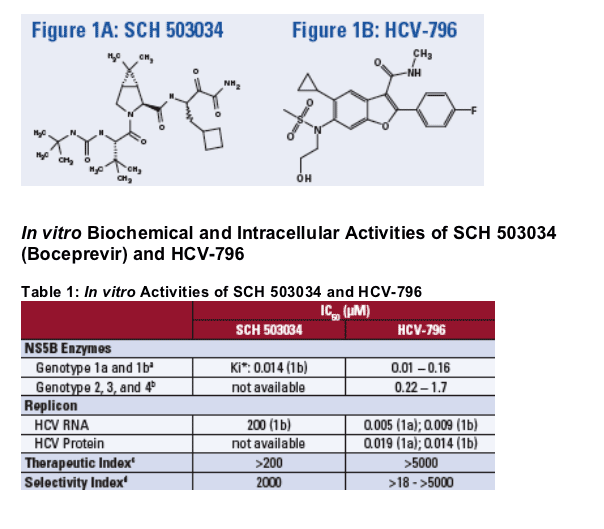
a: 3 isolates of genotype 1a and 6 isolates of genotype 1b for HCV-796.
b: 1 isolate each for HCV-796.
c: Based on the HCV and GAPDH RNAs for both HCV-796 and SCH 503034.
d: Enzyme panel for HCV-796 includes human polymerase _, _, _, HIV RT, calf thymus polymerase _; for SCH 503034 includes human neutrophil elastase.
Cross-Resistance Profiles of
SCH 503034 (Boceprevir) and HCV-796
SCH 503034 exhibited equivalent inhibitory activity against WT and HCV-796 resistant variants.
HCV-796 inhibited WT and resistant replicons selected by SCH 503034 with similar potency.
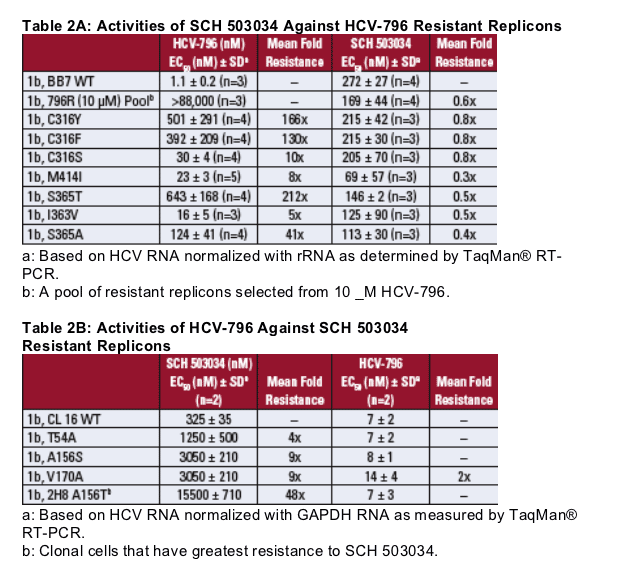
3-Day Combination of SCH 503034
(Boceprevir) and HCV-796
Time- and dose-dependent inhibition of replicon RNA was observed with both inhibitors.
Combination treatment achieved greater reduction in viral RNA than either agent used alone.
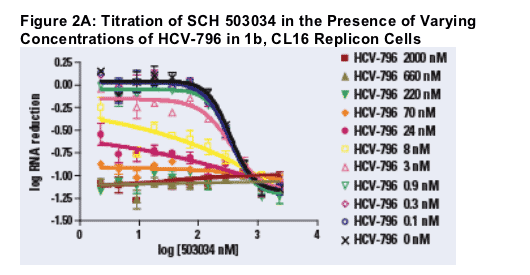
Replicon cells (CL16 genotype 1b) were treated for 3 days with SCH 503034 which was serially diluted at 1:2 for a 10-point titration. To each concentration of SCH 503034, the second inhibitor, HCV-796 was titrated in. The final concentrations of DMSO and fetal bovine serum were 1% and 10%, respectively. The replicon RNA level was measured using real time PCR (TaqMan assay). GAPDH RNA was used as an endogenous control. Replicon RNA reduction
was calculated as below:
- dCT=5BCT-gapdhCT
- ddCT=dCT-dCT of no cpd control
- log RNA reduction=log (1/2ddCT)
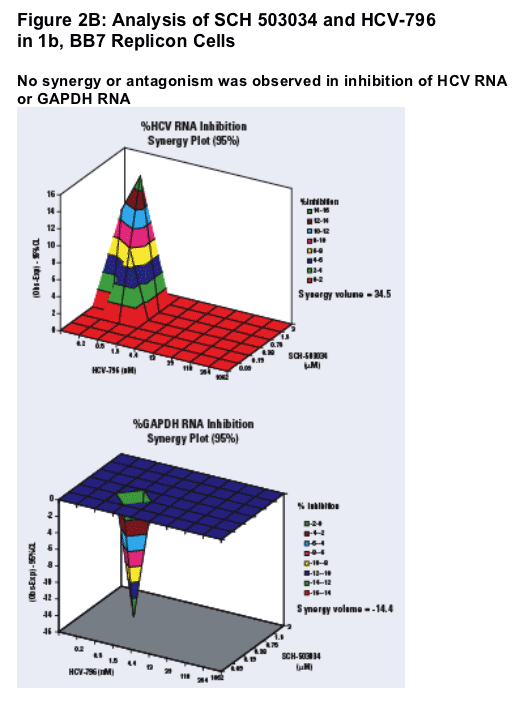
Genotype1b, BB7 replicon cells were treated with combinations of SCH 503034 and HCV-796 in the presence of 2% FBS without G418 for 3 days. HCV, GAPDH, and rRNA levels were quantified using TaqMan RT-PCR. The amounts of HCV and GAPDH RNAs were normalized with rRNA, and calculated using an external standard curve method. A 3-dimensional graphical representation of these data, at the 95% confidence intervals, is shown. Additive
interactions appear as a horizontal plane at 0%. Any peaks above the plane are indicative of synergy, or greater than expected effects. Conversely, peaks below the plane are indicative of antagonism, or less then expected effects. The degree of synergy or antagonism in the 3-dimensional graph can be quantified using the shading scale on the right. (Prichard MN, Aseltine KR, Shipman JC. MacSynergy II. Version 1.0. User's manual. Ann Arbor, MI: University of Michigan, 1993).
2-Week Combination of SCH 503034 (Boceprevir) and HCV-796
Estimation of Efficacy (_) Using the Perelson Bi-exponential Model
The data for HCV levels from one of three comparable studies are graphed in Figure 3.
-- The impact of combination therapy, throughout the time course, is equivalent to the sum of the impact of each drug independently (within experimental error)
-- Comparison of the efficacy parameter estimates (_ ) using the Perelson bi-exponential model suggests that the two agents are basically additive i.e. for independent therapies _comb = 1-[(1-_796)(1-_034)].
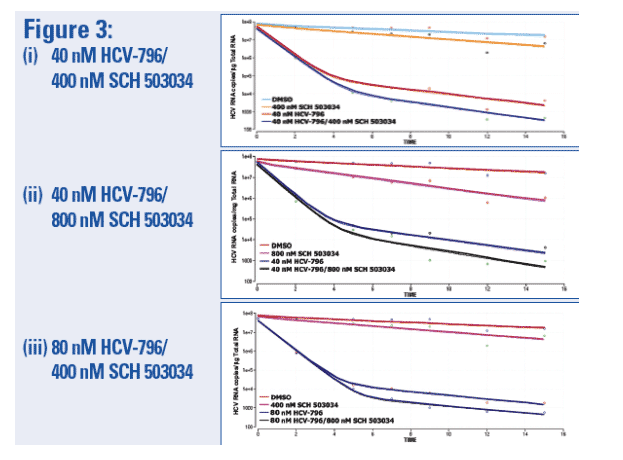
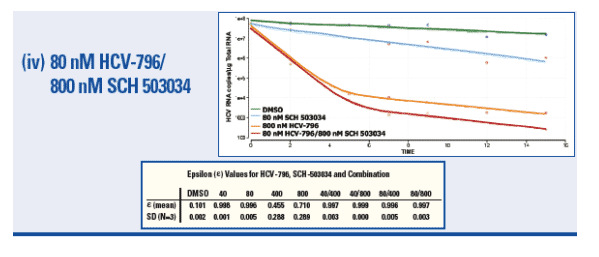
1b, BB7 cells were treated with the compounds at the specified concentrations under the same conditions as described in Figure 2B. The first (_) and second (_) phase slopes as well as initial RNA copy number were estimated by modification of the Perelson bi-exponential model (Neumann, A.U et al., 1998, Science, 282:103-107):
RNA(t) = RNA0[Ae -_1t + (1-A)e -_2t ]
where: _1,2 = 1/2{(c + _) ± [(c-_)2 + 4(1-_)c_]1/2}
_ = (_c - _2)/(_1 - _2)
and assuming the half-life of free cytosolic HCV RNA is ∼ 9 hr,
i.e. c = 1.8 (Dahari H, et al. 2007, J. Virol., 81: 750-760).
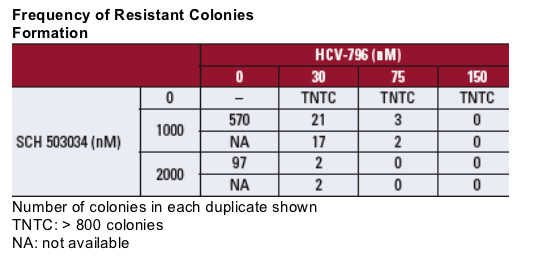
|
| |
|
 |
 |
|
|